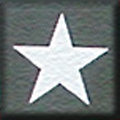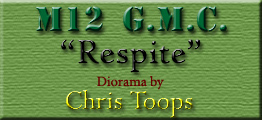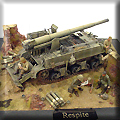|
Base: The base was an 8x10 picture frame. The glass of the frame kept the
celluclay medium from warping the entire project. While the celluclay was still wet, I
added surface detail such as tank tread imprints, recoil spade pit and the brick walls.
Once dry, the groundwork, which consisted of a mix of real dirt, several shades of static grass,
sand, small rocks, and diced raspberry root, was applied to the celluclay. Final touches
such as the brick rubble, gas cans, powder tubes etc. were then added.
|
|






![[The scene was to be the crew of M-12 taking a break and would be called Respite.]](CT-M12-017a1.jpg)
![[Tracks!]](CT-M12-031b.jpg)
![[I added detail to the kit bogie assembly by adding rivets]](CT-M12-032b.jpg)
![[Eduard photoetch tool tie downs.]](CT-M12-028b.jpg)
![[Eduard photoetch engine compartment screens]](CT-M12-039b.jpg)
![[The driver's compartment was to be left open]](CT-M12-037b.jpg)
![[Some details were added that included a scratch built drive shaft, driver's helmets, weapons etc.]](CT-M12-033b.jpg)
![[I did use an after market barrel, which was no easy find.]](CT-M12-027a.jpg)
![[I used Model Master enamels for the main colors.]](CT-M12-018a.jpg)
![[For weathering, I used a watercolor product called Gouache.]](CT-M12-030b.jpg)
![[Washes of Lamp Black, Raw Umber and Burnt Sienna were brushed onto the desired areas]](CT-M12-034b.jpg)
![[The figures used were Verlinden and Warriors.]](CT-M12-020a.jpg)
![[no two uniforms were to be the same color]](CT-M12-021b.jpg)
![[The faces were done in oils.]](CT-M12-023b.jpg)
![[The letter was made from Kleenex soaked in a white glue and water.]](CT-M12-019a.jpg)
![[For my first diorama, I was pleased with the results.]](CT-M12-024a.jpg)
![[The base was an 8x10 picture frame.]](CT-M12-025a.jpg)
